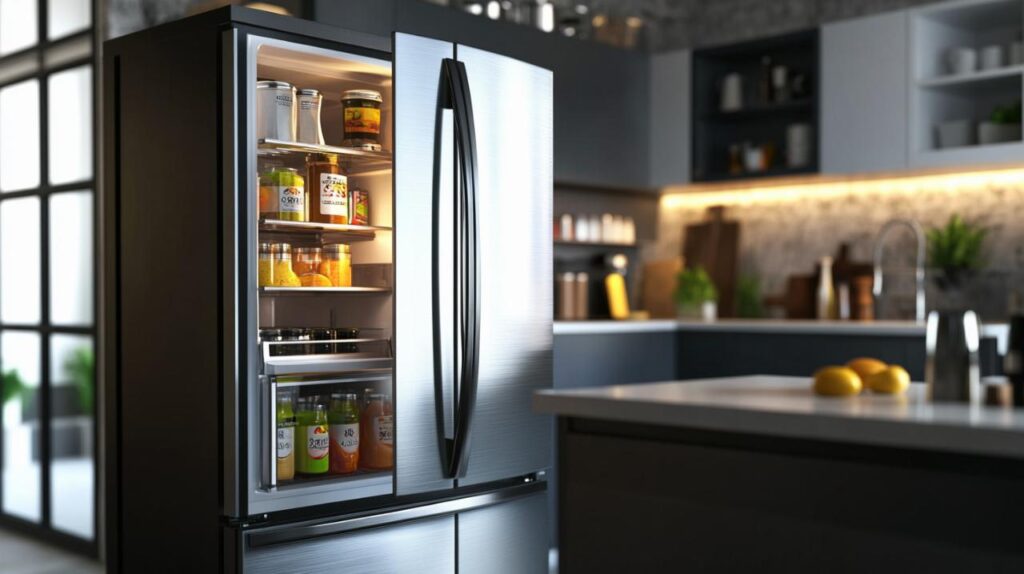Choosing the right appliance for your home can feel like quite the undertaking, particularly when it comes to large and impressive pieces like refrigeration units. The decision to invest in a sizable refrigerator means considering not only your immediate needs but also how the appliance will serve you over the years to come. With a bit of forethought and careful planning, you can ensure that your new purchase fits seamlessly into your home and lifestyle, providing both practicality and style.
Measuring up: getting the dimensions spot on
Taking accurate kitchen measurements
Before you even begin browsing models, it is absolutely essential to measure your kitchen space with precision. An american fridge for your kitchen is a substantial investment, and the last thing you want is to discover that your new appliance won't fit through the doorway or clashes with your cabinetry. Start by measuring the height, width, and depth of the area where you plan to position the fridge. Don't forget to measure doorways, hallways, and any tight corners that the delivery team will need to navigate. American-style models are typically wider than standard units, often ranging from seventy to ninety-one centimetres in width, and can be as deep as seventy-five centimetres. Heights usually fall between one hundred seventy-seven and one hundred eighty-nine centimetres, so it's crucial to ensure your kitchen can accommodate these generous dimensions.
Allowing for Proper Ventilation and Door Clearance
Once you've got the basic measurements sorted, you need to think about ventilation and door clearance. Leaving at least three centimetres of space around the unit is recommended to allow for proper airflow, which helps the appliance run efficiently and prolongs its lifespan. Additionally, consider how the doors will open in your kitchen layout. Some models are designed with doors that open at smaller angles, which can be a lifesaver in tighter spaces. Make sure there's enough room for the doors to swing open fully without hitting walls, cabinets, or other appliances. Taking these extra steps during the planning phase will save you considerable hassle and ensure your new fridge integrates smoothly into your kitchen environment.
Capacity considerations: matching storage to your household needs
Assessing your family size and shopping habits
The capacity of your fridge should align with your household's needs and shopping habits. For smaller households of one or two people, a model offering around two hundred litres may suffice, which equates to roughly eleven bags of shopping. Families of two to three people might find that four hundred litres, or about twenty-two bags of shopping, works well. Larger families with four to five members often benefit from six hundred litres of storage, accommodating approximately thirty-three bags of shopping. If your household is even larger or you prefer to stock up on groceries infrequently, models offering seven hundred litres or more could be the ideal choice. American-style models typically provide over four hundred litres of storage, making them particularly well-suited to larger families who need ample space for fresh produce, frozen goods, and beverages.
Understanding internal layout and storage options
Beyond sheer capacity, the internal layout of your fridge plays a significant role in how effectively you can use the available space. Look for models with adjustable shelves, door bins, and compartments that allow you to customise storage according to your needs. Some units offer dedicated zones for different types of food, with independent temperature controls that help keep fruits, vegetables, meats, and dairy products at their optimal freshness. Slimline models are also available for those who have smaller kitchens but still desire the benefits of an American-style appliance. Understanding how the interior is organised and whether it suits your lifestyle can make a real difference in your day-to-day experience.
Essential features versus nice-to-haves
Ice makers, water dispensers, and filtration systems
One of the most appealing features of many American-style models is the inclusion of water and ice dispensers. These add a layer of convenience, especially during warmer months or when entertaining guests. However, plumbed-in dispensers require access to a water supply and will need filter changes approximately every six months to maintain water quality and taste. If you don't have easy access to a water line or prefer not to deal with filter maintenance, you might opt for a model without these features or one with a non-plumbed water reservoir. It's important to weigh the convenience of having chilled water and ice on demand against the practicalities and ongoing costs associated with installation and upkeep.
Smart storage solutions and temperature controls
Modern refrigeration units come packed with technology designed to make your life easier. Look for features like the No Frost system, which prevents ice build-up and eliminates the need for manual defrosting. This not only saves time but also ensures consistent cooling performance. Independent temperature controls for the fridge and freezer compartments allow you to maintain optimal conditions for different types of food. Some models even offer a holiday mode, which keeps food fresh at a slightly higher temperature of around fourteen degrees Celsius while maintaining normal freezer settings, helping to save energy when you're away. Inverter compressors and advanced thermal insulation are also worth considering, as they contribute to quieter operation and improved energy efficiency.
Energy efficiency: keeping your electricity bills in check

Understanding energy ratings and running costs
Energy efficiency is a critical factor when selecting a large appliance, as it directly impacts your electricity bills and environmental footprint. Look for models with an energy rating of A+ to A+++. An A+ rated fridge uses approximately twenty percent less energy than a Class A model, whilst an A++ can reduce consumption by up to forty percent. Energy Star certified appliances use at least twenty percent less energy than standard models, and modern fridges can consume up to fifty percent less energy than those manufactured a decade ago. Whilst it might be tempting to save money upfront by choosing a less efficient model, the long-term savings on your energy bills can be substantial, making it well worth the initial investment.
Long-term savings with efficient models
Investing in an energy-efficient model is not just about reducing your monthly expenses; it's also about making a responsible choice for the environment. Features like inverter compressors and advanced thermal insulation help reduce energy consumption, ensuring that your appliance runs smoothly without placing undue strain on your home's electrical system. Over the lifespan of a fridge, which can be anywhere from ten to twenty years with proper maintenance, these savings add up considerably. Additionally, choosing a model with a solid reputation for reliability means fewer repair costs and a longer-lasting appliance, further enhancing the value of your purchase.
Setting a Realistic Budget for Your American Fridge
Price ranges and what they offer
American-style fridges are available across a wide price spectrum, and understanding what each range offers can help you make an informed decision. Entry-level models typically start around six hundred pounds, offering basic functionality and decent storage capacity without too many bells and whistles. Mid-range options, priced between one thousand and one thousand five hundred pounds, often include additional features such as water and ice dispensers, improved energy ratings, and more sophisticated internal layouts. Premium models, which can exceed two thousand pounds, tend to come with the latest technology, superior build quality, and advanced features like smart connectivity, multi-zone cooling, and bespoke finishes. Your budget should reflect not only what you can afford upfront but also the long-term value and running costs associated with the appliance.
Balancing Cost with Features and Quality
When setting your budget, it's important to strike a balance between cost, features, and quality. A more affordable model might be tempting, but if it lacks energy efficiency or essential features, you could end up spending more in the long run on electricity and maintenance. Conversely, splashing out on a top-of-the-range model with features you'll never use isn't a wise investment either. Consider which features are genuinely important to you and your household, and focus on finding a model that ticks those boxes without unnecessary extras. Brands like Beko, Samsung, Bosch, Balay, Whirlpool, and Teka are well-regarded and offer a range of models across different price points, making it easier to find something that suits your needs and budget.
Styling Your Kitchen: Choosing the Right Finish and Design
Popular Finishes from Stainless Steel to Matte Black
The aesthetic appeal of your fridge is an important consideration, as it will be a prominent feature in your kitchen. Stainless steel remains a classic and versatile choice, complementing a wide variety of kitchen styles and offering a sleek, professional appearance. Matte black finishes have grown in popularity, providing a bold, contemporary look that pairs beautifully with modern cabinetry and fixtures. White and cream finishes offer a timeless, clean aesthetic that works well in both traditional and minimalist kitchens. Some manufacturers also offer custom panel-ready models, allowing you to match the appliance seamlessly with your cabinetry for a fully integrated look. The finish you choose should not only reflect your personal taste but also coordinate with your existing kitchen design to create a cohesive and inviting space.
Coordinating with your existing kitchen aesthetic
Beyond the finish, think about the overall design and how it fits with your kitchen's aesthetic. Consider the handles, the layout of the doors, and even the internal lighting, which can add both functionality and visual appeal. If your kitchen has a modern, industrial vibe, a fridge with clean lines and a metallic finish might be the perfect complement. For a more traditional or country-style kitchen, a model with softer curves and a warmer finish could be more appropriate. Taking the time to consider these details ensures that your new appliance enhances the overall look and feel of your kitchen, rather than feeling like an afterthought. Remember, a fridge is a long-term investment, and choosing one that you'll continue to love for years to come is just as important as its practical features.

